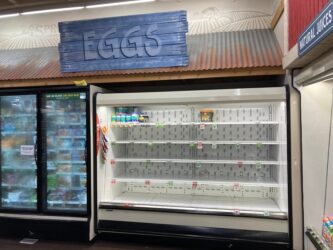Lawsuits Won’t Fix Soaring Egg Prices
Joel Salatin|February 7, 2023

A Note From Amanda: Soaring egg prices have become the poster child for inflation. Today, Joel explains the economics behind the spike and spells out what pitchfork-toting consumer advocacy groups don’t understand. It’s an issue that can’t be solved with lawsuits or complaints. And if you’re worried about the bite inflation has taken out of your wealth or your savings… stay tuned. Tomorrow we’ll be sharing brand-new research on how savvy investors are turning the tables. It all has to do with an incredible breakthrough in the red-hot energy sector. The exciting details will be revealed tomorrow.
Due to the spike in egg prices, consumer advocacy groups are now suing big egg companies, charging them with price gouging, price fixing and all sorts of illegal activity.
They allege that 58 million dead chickens is not really a big deal.
There are two huge problems with this suit.
First, let me assure you that the USDA’s response to highly pathogenic avian influenza (HPAI) is far from scientific or reasonable.
I recently spent time with several poultry farmers who went through the USDA protocol after discovering HPAI in their flocks. It sounds like something out of a science-fiction movie.
In fact, the industry now has a “Foaming Association” you can join in order to be first in line if your flock must be exterminated. They pump soap suds into the chicken house and suffocate the birds.
The term you’ll see in the press reports is “euthanized,” but normally that term is used to refer to a living creature that is hopelessly sick and in pain – and for which death is a welcome priority.
While HPAI can be deadly, by no means does it attack ubiquitously. For instance, one farmer had 15 flocks of 3,000 birds each. In the one flock that had HPAI, most of his birds died. But around 250 didn’t.
Again, I acknowledge that HPAI is deadly. But what if the 250 birds that had survived, showing no symptoms of disease, had not been exterminated with the rest?
What if those healthy survivors had instead been used to breed, offering genetic strength to their offspring? And what if that were done over and over?
The current protocols, which mandate the extermination of every bird on a farm even if only one tests positive for HPAI, go against everything we know about genetic adaptation and building immunity over generations.
Again… our bureaucrats’ response to HPAI has no merit in science or reason.
Now let’s talk pricing, the other big folly here.
Basic Math
Most people have no idea what kind of margins govern farming.
The big margins enjoyed by Big Tech have jaundiced the average mind when it comes to the food system. The margin on eggs, for example, is literally a few cents or even half a cent a dozen.
That is why the industrial farm sector scales houses into the thousands of birds and individual farms into the millions.
The folks behind these do-gooder, consumer advocate lawsuits don’t understand basic math.
If you have an extremely high margin, you can absorb a fairly sizable change in supply without upsetting your overall value chain or your inventory.
The bigger the margin is, the more forgiving the response time is and the more wiggle room there is between supply and demand.
But if supply and demand are extremely close, a minor hiccup in supply creates a major hiccup in the market.
If you have 100 widgets in supply and there is demand for 90, you have wiggle room. But if your supply is 100 and your demand is also 100, a drop to just 99 widgets in supply creates a big problem.
Either a customer goes without or the remaining customers bid up the price to ensure they are first in line.
The elasticity of the marketplace is a direct result of how closely supply tracks demand.
Of all the sectors in the economy, food has the least elasticity because it’s hard to store. You can store gold, gasoline, clothes, copper, knowledge and guns. But you can’t store oranges, eggs, milk or chicken – at least not for long. Perishability means that producers dare not stockpile lest they end up losing viable product.
Of course, buyers seldom care about this issue. They want cheap, dependable products.
Due to these hair-thin margins, a bump in the system quickly becomes catastrophic.
The outfits suing egg companies scoff at a supply reduction of less than 10%. But when you have a perishable product that sells at a 2% margin, a 6% supply hiccup multiplies into a substantial imbalance.
Who pays for the sudden feeding frenzy when folks realize they can’t get eggs?
When a kitchen staple is in short supply, its price doubles quickly.
That high price does many things.
First, it brings farmers like me – who create a different habitat and devote all our attention to building immune systems instead of tearing them down – some welcome compensation. Creating an immune-building environment by pasturing and moving animals, using non-GMO feeds, and running smaller flocks takes extra time and attention.
Second, it finances alternatives.
Third, it finances research into solutions.
Certainly our farm could be hit by HPAI tomorrow. I don’t want to sound cavalier. But as a culture, we must appreciate that maladies are symptomatic of many things. The experts say HPAI is transmitted by migratory waterfowl. Perhaps if our country hadn’t dried out our landscape, these birds would be less concentrated and happier… and therefore less risky.
As is the case in almost every sector these days, we have narrowly focused, impatient academics, largely financed by corrupt bureaucrats and agenda-driven multinational corporations, making decisions in agriculture. That ensures truly unbiased studies don’t exist.
Whether it’s a quick judgment about pricing, cause or solution, we don’t consider the many issues surrounding how to raise happy, healthy chickens.
If you expect the USDA to get to the bottom of it, I hate to disappoint you. It won’t.
Expect food prices to keep going up as the invisible hand of the market creates its own balance sheet.

Joel Salatin
Joel Salatin calls himself a Christian libertarian environmentalist capitalist lunatic farmer. Others who like him call him the most famous farmer in the world, the high priest of the pasture, and the most eclectic thinker from Virginia since Thomas Jefferson. Those who don’t like him call him a bioterrorist, Typhoid Mary, a charlatan, and a starvation advocate. With a room full of debate trophies from high school and college days, 12 published books, and a thriving multigenerational family farm, he draws on a lifetime of food, farming and fantasy to entertain and inspire audiences around the world.



